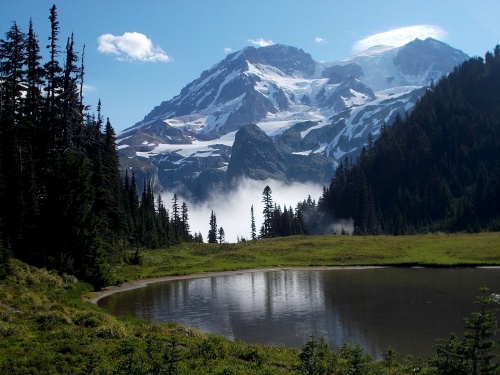How to Select a Camera

I’ve had quite a number of people ask me, “So Ryan, what kind of camera do you use?” It’s a good question on the surface—I’ll take thousands of photos on the trails I hike for this website. Seems like I should know what I’m doing, eh? The Tahoe Rim Trail required 2,247 photos. The Wonderland Trail left me with 1,988 photos. The Long Trail left me with another 2,922 photos. And on the Camino de Santiago, I took a whopping 7,899 photos. Even the short, 36-mile Crater Lake Trail left me with 755 photos—not including the 532 photos my friend, Leora, took on the same trip.
Not only is there the sheer quantity of photos I take on these trips to consider, but there’s also the very rugged conditions. I’ll push through snow, rain, dirt, grime and insects. These elements can destroy even the hardiest of cameras.
And some of those photos I’ve gotten are absolutely stunning!
The secret to all these photos... the Nikon Coolpix.
A lot of people seem surprised by this. It’s a relatively rudimentary camera by today’s standards, but there are several reasons I selected this particular model.
First, I wanted a camera that could use AA batteries. I can find AA batteries more-or-less anywhere in the world. Hiking through France and Spain on the Camino de Santiago—no problem! For most people, this isn’t really a serious consideration and the world is moving towards cameras that need charging. In the backcountry, however, it’s hard to recharge! And if you’re shooting hundreds or even thousands of photos between resupply points—well, I like knowing that I have enough batteries to see me through.
Speaking of batteries, I like cameras that use AA since they’re so ubiquious, but I also prefer the lithium versions. They cost considerably more than their alkaline counterparts, but they last far longer. I’ve taken over 1,000 photos with a single pair of lithium batteries while alkaline batteries barely reach 200 photos before pooping out. With as many photos that I take, I’d need to carry a whole pack of alkaline batteries, but I’ve never needed more than a pair of lithium batteries as spares. Fewer batteries to carry means less weight on my pack. Lithium batteries have a slight weight advantage over alkaline batteries as well, although it not so much that it’s a real consideration for me. Lithium batteries can be more difficult to find than alkaline ones, though, and sometimes in small towns and during my Camino walk in France, I had to resort to alkaline batteries. However, since they do wear out so quickly, it’s usually not long before they get replaced with lithium ones!
My second reason for selecting the Nikon Coolpix was because it’s relatively small, light and cheap. Small and light is always important when you’re backpacking, but cheap was an important consideration for me because I would be taking this camera into some severe conditions. There’s a very real chance that I would damage or destroy the camera along the way—it’s happened twice before (on the Florida Trail and West Coast Trail) and I have little doubt it will happen again. It’s less painful to both my wallet and my psych if I destroy a $100 camera rather than a $1,000 camera. Not that I’m jumping for joy when I destroy a $100 camera, but they’re a lot more disposable than an expensive camera. So small, light and cheap are all important considerations.
There are a lot of other camera features I’d love to have but don’t. I wish I could use it to take photos of starry nights, but it doesn’t work well for that. I wish it worked better in low-light conditions, but it doesn’t. I wish it were waterproof, drop-proof and weather-proof, but it’s not. For low-light conditions, I’ll rest the camera on a tree or a rock to take the photo, sometimes even using a self-timer so my clicking the shutter button doesn’t cause bluriness. Since it’s not waterproof, I’ll store the camera in a Ziplock bag on rainy days or when I’m crossing a particularly dangerous creek. And... I never have found a work around for taking photos of the incredible starry nights I’ve enjoyed. They’re limitations that I learned to live with.
Digital cameras spend a lot of time and energy trying to convince you that more megapixels is better, but for photos that are displayed on the web, you don’t need a lot of megapixels. My current camera supports up to 16 megapixels, but I usually set it to only store photos at 4 megapixels. It makes my memory cards last longer, sucks up less battery power and takes photos faster. And I still have to shrink the photos considerably for web use!
Nowadays, I always carry a backup camera on my hikes—an older model of the Nikon Coolpix. Just in case something happens to my main camera—and eventually, something will happen to it!—I won’t miss any section of the trail I’m hiking. It’s an added weight that I’d rather not carry, but now that I’m working on the trail, I feel it’s important to carry a backup camera. It’s a small price to pay for such a wonderful job, though!

